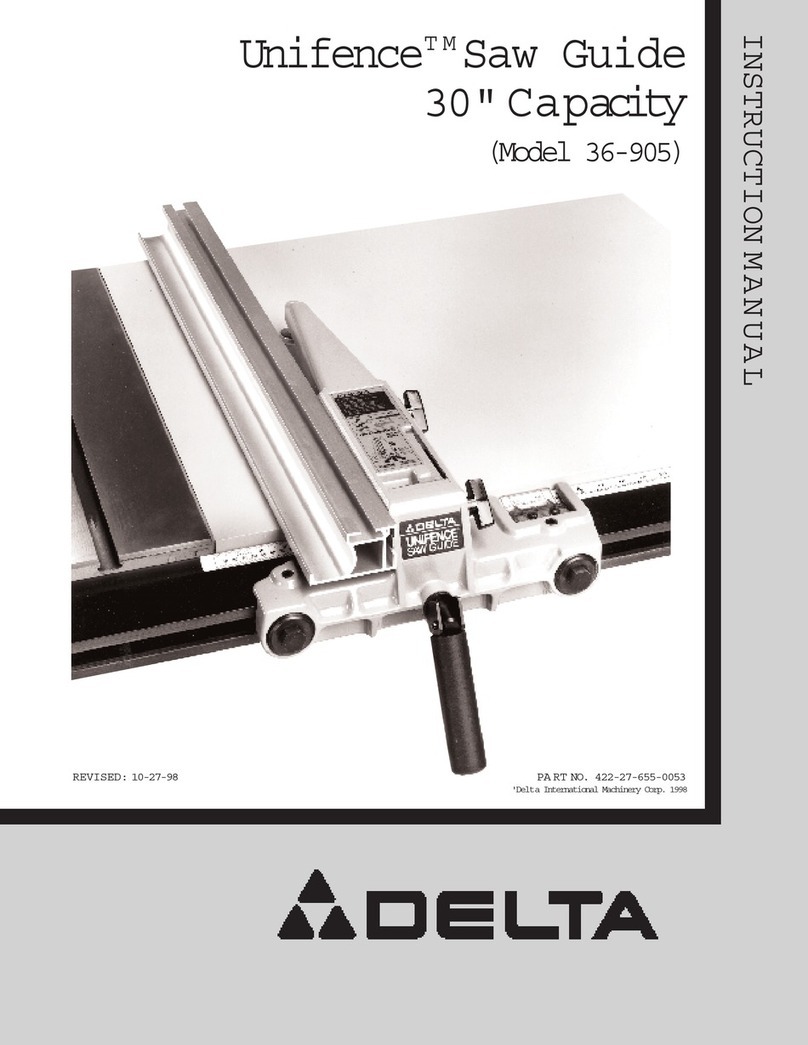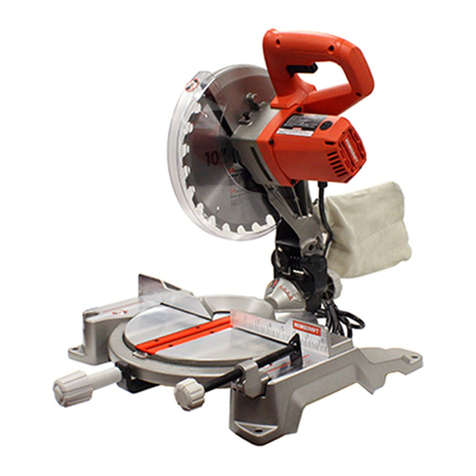Delta Unisaw 36-841 User manual

INSTRUCTION MANUAL
Limited Edition Unisaw®with
52" Unifence®
(Model 36-841)
36-841 Consists of:
36-829 Base Unit
36-937 10" Cast Iron Wings(2)
36-918 (52") Unifence Assembly
36-978 Gray table boards
36-904 Unifence Front Rail with Stop
35-617 Carbide Blade
50-289 Mobile Base
36-862 Zero Clearance Insert
PART NO. 422-04-651-0063 (01-15-02)
Copyright © 2002 Delta Machinery
To learn more about DELTA MACHINERY
visit our website at: www.deltamachinery.com.
For Parts, Service, Warranty or other Assistance,
please call 1-800-223-7278 (In Canada call 1-800-463-3582).
Limited Edition Unisaw®with
50" Commercial Biesemeyer
Fence System
(Model 36-843)
36-843 Consists of:
36-829 Base Unit
36-937 10" Cast Iron Wings(2)
78-995 (50") Biesemeyer Fence Assembly
78-996 Commercial Fence with Legs
78-924 Gray table boards
35-617 Carbide Blade
50-289 Mobile Base
36-862 Zero Clearance Insert

2
GENERAL SAFETY RULES
Woodworking can be dangerous if safe and proper operating procedures are not followed. As with all machinery, there
are certain hazards involved with the operation of the product. Using the machine with respect and caution will
considerably lessen the possibility of personal injury. However, if normal safety precautions are overlooked or ignored,
personal injury to the operator may result. Safety equipment such as guards, push sticks, hold-downs, featherboards,
goggles, dust masks and hearing protection can reduce your potential for injury. But even the best guard won’t make
up for poor judgment, carelessness or inattention. Always use common sense and exercise caution in the workshop.
If a procedure feels dangerous, don’t try it. Figure out an alternative procedure that feels safer. REMEMBER: Your
personal safety is your responsibility.
This machine was designed for certain applications only. Delta Machinery strongly recommends that this machine not
be modified and/or used for any application other than that for which it was designed. If you have any questions relative
to a particular application, DO NOT use the machine until you have first contacted Delta to determine if it can or should
be performed on the product.
Technical Service Manager
Delta Machinery
4825 Highway 45 North
Jackson, TN 38305
(IN CANADA: 505 SOUTHGATE DRIVE, GUELPH, ONTARIO N1H 6M7)
WARNING: FAILURE TO FOLLOW THESE RULES MAY RESULT IN SERIOUS PERSONAL INJURY
1. FOR YOUR OWN SAFETY, READ INSTRUCTION
MANUAL BEFORE OPERATING THE TOOL. Learn the
tool’s application and limitations as well as the specific
hazards peculiar to it.
2. KEEP GUARDS IN PLACE and in working order.
3. ALWAYS WEAR EYE PROTECTION.
Wear safety
glasses. Everyday eyeglasses only have impact resistant
lenses; they are not safety glasses. Also use face or dust
mask if cutting operation is dusty. These safety glasses
must conform to ANSI Z87.1 requirements. Note:
Approved glasses have Z87 printed or stamped on them.
4. REMOVE ADJUSTING KEYS AND WRENCHES. Form
habit of checking to see that keys and adjusting wrenches
are removed from tool before turning it “on”.
5. KEEP WORK AREA CLEAN. Cluttered areas and
benches invite accidents.
6. DON’T USE IN DANGEROUS ENVIRONMENT. Don’t
use power tools in damp or wet locations, or expose them
to rain. Keep work area well-lighted.
7. KEEP CHILDREN AND VISITORS AWAY. All children
and visitors should be kept a safe distance from work area.
8. MAKE WORKSHOP CHILDPROOF – with padlocks,
master switches, or by removing starter keys.
9. DON’T FORCE TOOL. It will do the job better and be
safer at the rate for which it was designed.
10. USE RIGHT TOOL. Don’t force tool or attachment to
do a job for which it was not designed.
11. WEAR PROPER APPAREL. No loose clothing, gloves,
neckties, rings, bracelets, or other jewelry to get caught in
moving parts. Nonslip footwear is recommended. Wear
protective hair covering to contain long hair.
12. SECURE WORK. Use clamps or a vise to hold work
when practical. It’s safer than using your hand and frees
both hands to operate tool.
13. DON’T OVERREACH. Keep proper footing and
balance at all times.
14. MAINTAIN TOOLS IN TOP CONDITION. Keep tools
sharp and clean for best and safest performance. Follow
instructions for lubricating and changing accessories.
15. DISCONNECT TOOLS before servicing and when
changing accessories such as blades, bits, cutters, etc.
16. USE RECOMMENDED ACCESSORIES. The use of
accessories and attachments not recommended by Delta
may cause hazards or risk of injury to persons.
17. REDUCE THE RISK OF UNINTENTIONAL STARTING.
Make sure switch is in “OFF” position before plugging in
power cord.
In the event of a power failure, move switch
to the “OFF” position.
18. NEVER STAND ON TOOL. Serious injury could occur if
the tool is tipped or if the cutting tool is accidentally
contacted.
19. CHECK DAMAGED PARTS. Before further use of the
tool, a guard or other part that is damaged should be
carefully checked to ensure that it will operate properly and
perform its intended function – check for alignment of
moving parts, binding of moving parts, breakage of parts,
mounting, and any other conditions that may affect its
operation. A guard or other part that is damaged should be
properly repaired or replaced.
20. DIRECTION OF FEED. Feed work into a blade or
cutter against the direction of rotation of the blade or cutter
only.
21. NEVER LEAVE TOOL RUNNING UNATTENDED.
TURN POWER OFF. Don’t leave tool until it comes to a
complete stop.
22.
STAY ALERT, WATCH WHAT YOU ARE DOING, AND
USE COMMON SENSE WHEN OPERATING A POWER
TOOL. DO NOT USE TOOL WHILE TIRED OR UNDER
THE INFLUENCE OF DRUGS, ALCOHOL, OR
MEDICATION. A moment of inattention while operating
power tools may result in serious personal injury.
23. MAKE SURE TOOL IS DISCONNECTED FROM
POWER SUPPLY while motor is being mounted,
connected or reconnected.
24. THE DUST GENERATED by certain woods and wood
products can be injurious to your health. Always operate
machinery in well ventilated areas and provide for proper
dust removal. Use wood dust collection systems whenever
possible.
25.
WARNING: SOME DUST CREATED BY
POWER SANDING, SAWING, GRINDING, DRILLING,
AND OTHER CONSTRUCTION ACTIVITIES contains
chemicals known to cause cancer, birth defects or other
reproductive harm. Some examples of these chemicals
are:
· lead from lead-based paints,
· crystalline silica from bricks and cement and other
masonry products, and
· arsenic and chromium from chemically-treated lumber.
Your risk from these exposures varies, depending on how
often you do this type of work. To reduce your exposure
to these chemicals: work in a well ventilated area, and
work with approved safety equipment, such as those
dust masks that are specially designed to filter out
microscopic particles.
SAVE THESE INSTRUCTIONS.
Refer to them often and use them to instruct others.

ADDITIONAL SAFETY RULES FOR
CIRCULAR SAWS
3
WARNING: FAILURE TO FOLLOW THESE RULES MAY RESULT IN SERIOUS PERSONAL INJURY
SAVE THESE INSTRUCTIONS.
Refer to them often
and use them to instruct others.
1. DO NOT OPERATE THIS MACHINE until it is
assembled and installed according to the
instructions.
2. OBTAIN ADVICE FROM YOUR SUPERVISOR,
instructor, or another qualified person if you are
not familiar with the operation of this machine.
3. FOLLOW ALL WIRING CODES and recommended
electrical connections.
4. USE THE GUARDS WHENEVER POSSIBLE.
Check to see that they are in place, secured, and
working correctly.
5. AVOID KICKBACK by:
A. keeping blade sharp and free of rust and pitch.
B. keeping rip fence parallel to the saw blade.
C. using saw blade guard and spreader for every
possible operation, including all through
sawing.
D. pushing the workpiece past the saw blade prior
to release.
E. never ripping a workpiece that is twisted or
warped, or does not have a straight edge to
guide along the fence.
F. using feather boards when the anti-kickback
device cannot be used.
G. never sawing a large workpiece that cannot be
controlled.
H. never using the fence as a guide when
crosscutting.
I. never sawing a workpiece with loose knots or
other flaws.
6. ALWAYS USE GUARDS, SPLITTER, AND ANTI-
KICKBACK FINGERS except when otherwise
directed in the manual.
7. REMOVE CUT-OFF PIECES AND SCRAPS from
the table before starting the saw. The vibration of the
machine may cause them to move into the saw
blade and be thrown out. After cutting, turn the
machine off. When the blade has come to a
complete stop, remove all debris.
8. NEVER START THE MACHINE with the workpiece
against the blade.
9. HOLD THE WORKPIECE FIRMLY against the miter
gauge or fence.
10. NEVER run the workpiece between the fence and a
moulding cutterhead.
11. NEVER perform “free-hand” operations. Use either
the fence or miter gauge to position and guide the
workpiece.
12. USE PUSH STICK(S) for ripping a narrow
workpiece.
13. AVOID AWKWARD OPERATIONS AND HAND
POSITIONS where a sudden slip could cause a
hand to move into the blade.
14. KEEP ARMS, HANDS, AND FINGERS away from
the blade.
15. NEVER have any part of your body in line with the
path of the saw blade.
16. NEVER REACH AROUND or over the saw blade.
17. NEVER attempt to free a stalled saw blade without
first turning the machine “OFF”.
18. PROPERLY SUPPORT LONG OR WIDE
workpieces.
19. NEVER PERFORM LAYOUT, assembly or set-up
work on the table/work area when the machine is
running.
20. TURN THE MACHINE “OFF” AND DISCONNECT
THE MACHINE from the power source before
installing or removing accessories, before adjusting
or changing set-ups, or when making repairs.
21. TURN THE MACHINE “OFF”, disconnect the
machine from the power source, and clean the
table/work area before leaving the machine. LOCK
THE SWITCH IN THE “OFF” POSITION to prevent
unauthorized use.
22. ADDITIONAL INFORMATION regarding the safe
and proper operation of this tool is available from
the Power Tool Institute, 1300 Summer Avenue,
Cleveland, OH 44115-2851. Information is also
available from the National Safety Council, 1121
Spring Lake Drive, Itasca, IL 60143-3201. Please
refer to the American National Standards Institute
ANSI 01.1 Safety Requirements for Woodworking
Machines and the U.S. Department of Labor OSHA
1910.213 Regulations.

4
POWER CONNECTIONS
A separate electrical circuit should be used for your machines. This circuit should not be less than #12 wire and should
be protected with a 20 Amp time lag fuse. If an extension cord is used, use only 3-wire extension cords which have 3-
prong grounding type plugs and matching receptacle which will accept the machine’s plug. Before connecting the
motor to the power line, make sure the switch is in the “OFF” position and be sure that the electric current is of the
same characteristics as indicated on the machine. All line connections should make good contact. Running on low
voltage will damage the motor.
WARNING: DO NOT EXPOSE THE MACHINE TO RAIN OR OPERATE THE MACHINE IN DAMP LOCATIONS.
MOTOR SPECIFICATIONS
Your machine is wired for 230 volt, 60 HZ alternating current. Before connecting the machine to the power source,
make sure the switch is in the “OFF” position.
GROUNDING INSTRUCTIONS
WARNING: THIS MACHINE MUST BE GROUNDED WHILE IN USE TO PROTECT THE OPERATOR FROM
ELECTRIC SHOCK.
2. Grounded, cord-connected machines intended for
use on a supply circuit having a nominal rating between
150 - 250 volts, inclusive:
This machine is intended for use on a circuit that has an
outlet that looks like the one illustrated in Fig. C. The
machine has a grounding plug that looks like the plug
illustrated in Fig. C. Make sure the machine is connected
to an outlet having the same configuration as the plug.
No adapter is available or should be used with this
machine. If the machine must be reconnected for use on
a different type of electric circuit, the reconnection
should be made by qualified service personnel; and after
reconnection, the machine should comply with all local
codes and ordinances.
WARNING: IN ALL CASES, MAKE SURE THE
RECEPTACLE IN QUESTION IS PROPERLY
GROUNDED. IF YOU ARE NOT SURE HAVE A QUALIFIED
ELECTRICIAN CHECK THE RECEPTACLE. NEVER
REMOVE GROUNDING PRONG FROM POWER PLUG.
NOTE: In Canada, the use of a temporary adapter is not
permitted by the Canadian Electric Code.
1. All grounded, cord-connected machines:
In the event of a malfunction or breakdown, grounding
provides a path of least resistance for electric current to
reduce the risk of electric shock. This machine is
equipped with an electric cord having an equipment-
grounding conductor and a grounding plug. The plug must
be plugged into a matching outlet that is properly installed
and grounded in accordance with all local codes and
ordinances.
Do not modify the plug provided - if it will not fit the outlet,
have the proper outlet installed by a qualified electrician.
Improper connection of the equipment-grounding
conductor can result in risk of electric shock. The
conductor with insulation having an outer surface that is
green with or without yellow stripes is the equipment-
grounding conductor. If repair or replacement of the
electric cord or plug is necessary, do not connect the
equipment-grounding conductor to a live terminal.
Check with a qualified electrician or service personnel if
the grounding instructions are not completely understood,
or if in doubt as to whether the machine is properly
grounded.
Use only 3-wire extension cords that have 3-prong
grounding type plugs and matching 3-conductor
receptacles that accept the machine’s plug, as shown in
Fig. C.
Repair or replace damaged or worn cord immediately.
Fig. C
CURRENT CARRYING
PRONGS
GROUNDED OUTLET BOX
GROUND
PRONG
240
VOLT

Use proper extension cords. Make sure your extension cord is in good condition and is a 3-wire extension cord which
has a 3-prong grounding type plug and matching receptacle which will accept the machine’s plug. When using an
extension cord, be sure to use one heavy enough to carry the current of the machine. An undersized cord will cause
a drop in line voltage, resulting in loss of power and overheating. Fig. D, shows the correct gauge to use depending
on the cord length. If in doubt, use the next heavier gauge. The smaller the gauge number, the heavier the cord.
EXTENSION CORDS
OPERATING INSTRUCTIONS
FOREWORD
The Limited Edition 10" Unisaw is available with either the 52" Unifence Saw guide, or the 50" Commercial Biesemeyer
Fence system. The Limited Edition 10" Unisaw is a very powerful machine. The motor is single phase, 3 horse power,
230 volt motor that turns the circular blade at 4000 RPMs. The Unisaw is a versatile machine, in that it can do precision
ripping, cross-cutting, dadoing, moulding and tenoning.
UNPACKING AND CLEANING
Carefully unpack the machine and all loose items from the shipping container(s). Remove the protective coating from
all unpainted surfaces. This coating may be removed with a soft cloth moistened with kerosene (do not use acetone,
gasoline or lacquer thinner for this purpose). After cleaning, cover the unpainted surfaces with a good quality household
floor paste wax. Figures 1 and 2, illustrate the saw and all loose items supplied with the machine. Figs. 3, 4, and 5,
illustrate the items supplied with the fence system.
IMPORTANT: The saw is shipped with the saw arbor in the 45 degree position. NOTE: THE HAND WHEEL MUST BE
ASSEMBLED TO THE SAW, SEE THE SECTION “ASSEMBLING BLADE TILTING MECHANISM”, THEN PROCEED
WITH THE FOLLOWING. Loosen locking knob on the handwheel (A) Fig. 1, and turn handwheel until the saw arbor is
in the 90 degree position and remove the styrofoam packing from inside the saw cabinet. Tighten locking knob.
NOTICE: THE MANUAL COVER PHOTO ILLUSTRATES THE CURRENT
PRODUCTION MODEL. ALL OTHER ILLUSTRATIONS ARE REPRESENTATIVE
ONLY AND MAY NOT DEPICT THE ACTUAL COLOR, LABELING OR
ACCESSORIES.
5
Fig. D
MINIMUM GAUGE EXTENSION CORD
RECOMMENDED SIZES FOR USE WITH STATIONARY ELECTRIC MACHINES
Ampere Total Length Gauge of
Rating Volts of Cord in Feet Extension Cord
0-6 240
up to
50 18 AWG
0-6 240 50-100 16 AWG
0-6 240 100-200 16 AWG
0-6 240 200-300 14 AWG
6-10 240
up to
50 18 AWG
6-10 240 50-100 16 AWG
6-10 240 100-200 14 AWG
6-10 240 200-300 12 AWG
10-12 240
up to
50 16 AWG
10-12 240 50-100 16 AWG
10-12 240 100-200 14 AWG
10-12 240 200-300 12 AWG
12-16 240
up to
50 14 AWG
12-16 240 50-100 12 AWG
12-16 240
GREATER THAN 100 FEET NOT RECOMMENDED

6
Fig. 1
UNISAW
1. Unisaw
2. Switch
3. Motor cover
4. Blade guard and splitter bracket
5. Support rod
6. 5/8" Internal tooth washer
7. 5/8-18 Jam nut
8. Upper bracket for splitter
9. Lower bracket for support rod
10. 5/16" l.D. Flat washers (2)
11. 5/16" l.D. Lockwashers (3)
12. 5/16-18 x 1" hex head cap screws (4)
13. Arbor wrenches (2)
14. 1/8" and 5/64" hex wrenches
15. Miter gage
16. Flat washer for miter gage handle
17. Handle for miter gage
18. Cap for miter gage handle
19. Dust chute adapter
20. #10 x 1/2" hex washer head
screws (8)
21. Extension Wing (2)
22. Hangers for rip fence (2)
23. Flat head screw for mounting switch
24. Flat washer for mounting switch
25. Hex nut for mounting switch
26. Cable tie
27. Handwheel
28. Locknob
29. 7/16-20x1¼" Hex head screw (6)
30. 7/16" Flat washer (6)
31. Fiber washer (for handwheel)
32. Key (for handwheel)
Fig. 2
3
4
5
6
7
8
9
10 11
12
13
14
15
16
17
18
19
20
21 22
23 24
25
26
27
28
30
29
31
32
A
1
2

7
52" UNIFENCE
1. Unifence body (1)
2. Fence (1)
3. Leg/Shelf support bracket
4. Legs (2)
5. Table support brackets (2)
6. Unifence cursor (1)
7. Unifence guide rail (1)
8. #8 x 7/8" wood screws (19)
9. Z brackets (3)
10. Angle brackets (3)
11. Guide rail end caps (2)
12. 7/16-20 x 3/4" bolt, lockwasher, flat washer, (3)
13. 1/4-20 x 5/8" bolt, flat washer, nut, (4)
14. 3/8-16 x 1" bolt, flat washer, nut, (2)
15. 3/8-16x2½" bolt, (2)
16. Rail stop (1) (Parts in bag)
17. Leveling screw, nut, (2)
18. Table (1)
19. Shelf (1)
20. 1/4-20x3/4 Carriage head bolt (3)
* U-bolts (2)
* Leg insert (2)
*(Not Shown)
1
2
34
5
6
7
8
9
10
11 12
13
14
15
16
17
18
19
Fig. 3
20

8
50" COMMERCIAL BIESEMEYER FENCE SYSTEM
NOTE: A common hardware package is used for
several different models, therefore you may have
leftover hardware. Fig. 4
1 - Rear Rail
2 - Front Rail
3 - Guide Tube
4 - T-Square®Fence Assembly
5 - Cable Strap
6 - Template for aligning front rail to saw table
for fastening front and rear rails to right extension
table Fig. 4
7 - 1-1/2" long flat head Phillips screws (12)
8 - 1-1/4" O.D. Flat Washers (12)
9 - 1/4-20 hex nuts (12)
for fastening rear rail to saw table Fig. 4
10 - 3/8-24 x 1-1/4" long hex head cap screws (2)
11 - 7/8" O.D. flat washers (2)
12 - Lock washers (2)
for fastening front rail to saw table Fig. 4
13 - 3/8-16 x 1-1/4" long flat head Phillips screws (2)
14 - 7/8" O.D. flat washers (2)
15 - Lock washers (2)
16 - 3/8-16 hex nuts (2)
for fastening guide tube to front rail Fig. 4
17 - 1/2 long hex screws (9)
18 - Lock washers (9)
leg hardware Fig. 5
19 - Legs (2)
20 - 5/8" long wood screws #8 (8)
21 - 1/4-20 x 1-1/2" long flat head phillips screws (4)
22 - 1/4" flat washers (4)
23 - 1/4-20 hex nuts (4)
1
23
4
5
6
7
89
12
10
11
13
14
15
16
17 18
19
20
21
22
23
LIMITED EDITION UNISAW ASSEMBLY
INSTRUCTIONS
WARNING: FOR YOUR OWN SAFETY, DO NOT CONNECT THE SAW TO THE POWER SOURCE UNTIL THE
SAW IS COMPLETELY ASSEMBLED AND YOU READ AND UNDERSTAND THE ENTIRE INSTRUCTION MANUAL.
Fig. 4 Fig. 5
ASSEMBLING BLADE
TILTING MECHANISM
HANDLE
1. Install fiber washer (A) Fig. 6A, on the blade tilting
mechanism shaft (B). Install key (C), into shaft keyway.
2. Place handwheel (D) on shaft (B) Fig. 6A. Make sure
the groove (E), in the handwheel lines up with the key (C).
3. Push the handwheel snugly against the fiber washer
and tighten the set screw.
Fig. 6A
C
B
A
D
E

9
ASSEMBLING ON/OFF
SWITCH
1. The on/off switch (A) Fig. 10, is shipped attached to a
mounting bracket at the right side of the machine.
2. Loosely assemble switch and switch bracket (A) Fig.
10A, to the inside front lip of the left extension table with
hex flat head screw (D), flat washer (E), and hex nut (F)
through hole (G).
3. Attach the side of switch bracket (A) Fig. 10B, to the
inside of extension table at the front of the saw using the
7/16-20x1-1/4" screw and flat washer (C). Tighten screws
(C) and (D).
Fig. 10
Fig. 10A Fig.10B
A
F
E
D
G
D
C
A
4. Install lock knob (F) Fig. 6B, into threaded end of the
shaft (B). Hand-tighten lock knob at this time. (Do not
over tighten - see “Blade Raising Mechanism”)
Fig. 6B
ASSEMBLING EXTENSION
WINGS
Assemble the extension wings (A) Fig. 7 and Fig. 9, to the
saw table using the six 7/16"-20x11/4" hex head screws
(B) and 7/16" flat washers supplied. Use a straight edge
(C) Fig. 8, to make sure the extension wings (A) are level
with the saw table before tightening the screws (B) Fig. 7
and Fig. 9. NOTE: MAKE SURE FRONT EDGE OF WING
IS FLUSH TO OR SLIGHTLY BEHIND THE FRONT
EDGE OF THE TABLE.
NOTE: When assembling the left extension wing, do
not install the front screw and washer at this time, it
will be installed when assembling the on/off switch.
Fig. 7
A
B
Fig. 8
Fig. 9
A
C
A
B
A
F
B

10
ASSEMBLING BLADE
GUARD AND SPLITTER
ASSEMBLY
CAUTION: MAKE CERTAIN THE MACHINE IS
DISCONNECTED FROM THE POWER SOURCE.
1. Remove the table insert Fig. 11. Raise the saw arbor,
by turning the locking handle on the front of the saw,
counter clockwise and then turn the wheel on the front of
the saw clockwise as far as it will go, and remove the saw
blade from the machine by following the instructions in
section “REMOVING THE SAW BLADE”.
2. The inside splitter mounting bracket (A) Fig. 12, is
assembled to the inside of the saw and aligned with the
inside blade flange (B) at the factory.
3. To check the alignment, remove screw and fastener
plate (C) Fig. 12. Using a straight edge (D) Fig. 13, check
to see if the splitter bracket (A) is aligned with the inside
blade flange (B). Check both the top and bottom of
bracket (A) with the top and bottom of flange (B).
4. If an adjustment is necessary, loosen two screws (F)
Fig. 14, and adjust splitter bracket (A) until it is aligned
with the inside blade flange (B) Fig. 12. Tighten two
screws (F). Loosely assemble screw and fastener plate
(C), which were removed in STEP 3.
5. Insert threaded end of support rod (G) Fig. 15,
through slot in rear of saw and into hole in rear trunnion
(H). Fasten support rod (G) to trunnion with star washer
and hex nut (J) Fig. 16. NOTE: Thread nut (J) Fig. 16, onto
threads of support rod (G) as much as possible by hand.
Fig. 11 Fig. 12
Fig. 13
Fig. 14
Fig. 15 Fig. 16
A
C
B
A
D
B
F
A
J
GH

11
6. Using a wrench to hold the hex nut (J) Fig. 16, tight-
en rod (G) Fig. 17, with a small screwdriver (K) or similar
device through the hole in the end of the rod as shown.
7. Assemble lower bracket (L) Fig. 18, to rod (G) and
loosely tighten with two one-inch long hex head screws
(S) and lockwashers from underneath bracket (L).
8. Assemble upper splitter bracket (M) Fig. 19, to lower
bracket (L) using one-inch long hex head screw (N) with
lockwasher and flat washer. NOTE: Do not tighten screw
(N) at this time.
9. Insert the front end of splitter (P) Fig. 20, inside the
splitter mounting bracket behind splitter fastener plate
and screw (C). Push splitter down as far as possible,
making certain the bottom edge of splitter (P) is parallel
with the table surface. Tighten screw (C). Fasten splitter
and blade guard assembly (P) Fig. 21, to bracket (M)
using one-inch long screw (V) and flat washer.
10. IMPORTANT: The splitter (P) Fig. 22, features a notch
(W) cut into the top edge. Simply raise the front of the
clear blade guard (P) Fig. 22, until the rear edge of the
guard slips into notch (W) of the splitter. This notch
enables the blade guard to stay in the raised position and
makes changing blades easier.
Fig. 17 Fig. 18
Fig. 19
Fig. 20
Fig. 21
P
C
Fig. 22
K
G
S
L
G
M
NL
P
M
V
PW

12
11. Reassemble the saw blade, making certain the teeth
are pointing down at the front of the saw table as shown
in Fig. 23, and assemble the outside blade flange and
arbor nut (X). With open end wrench (Y) on the flats of the
arbor to keep it from turning, tighten arbor nut by turning
box end wrench (Z) counterclockwise.
12. Using a straight edge (A) Fig. 24, make certain the
splitter (P) is aligned with the saw blade (B). Using a
square (C) Figs. 25 and 26, make certain saw blade (B)
Fig. 25, and splitter (P) Fig. 26, are 90 degrees to the table
surface. Once you are certain the splitter is aligned to the
saw blade and table, tighten all splitter mounting
hardware (D) Fig. 26 and recheck alignment.
13. Holding the clear blade guard, lower the saw blade
and assemble the table insert (E) Fig. 27, into the opening
on the saw table.
Fig. 23 Fig. 24
A
P
B
X
Z
Y
Fig. 25
Fig. 26 Fig. 27
E
FASTENING MOTOR CORD
TO SAW FRAME
1. IMPORTANT: Turn the blade tilting handwheel
counterclockwise as far as it will go until the saw blade is
in the 45 degree position.
2. IMPORTANT: Turn the blade raising and lowering
handwheel counterclockwise until the blade is at its
lowest position.
3. Fasten motor cord (A) Fig. 27A to the saw frame
cross member (B), using the cable tie (C) supplied with
the saw. CAUTION: Before tightening the cable tie, make
certain that cord (A) is free of any interference from the
motor or saw blade at all possible positions of the motor.
4. After the cable tie is tightened, cut off excess tail of
cable tie (C) Fig. 27A.
Fig. 27A
C
B
A
B
P
D

13
Fig. 31
ASSEMBLING RIP FENCE
HOLDER BRACKETS
Assemble the rip fence holder brackets (A) and (B) Fig.
32A, to the four holes located in the left hand side of the
saw cabinet using four #10x1/2" sheet metal screws
supplied.
Fig. 32A
A
B
A
Fig. 32B
A
B
ASSEMBLING DUST CHUTE
ADAPTER
The Unisaw is supplied with a dust chute connector to
provide a means of connecting a 4" diameter dust
collector hose to the machine. Align the four holes in the
dust chute adapter (A) Fig. 32B,with the four holes in the
back of the saw cabinet (B) and attach the dust chute
adapter with four #10 x 1/2" sheet metal screws. NOTE:
DO NOT MOUNT THE DUST CHUTE ADAPTER
UNLESS A DUST COLLECTION SYSTEM IS USED IN
CONJUNCTION WITH THE SAW, FOR THE DUST
CHUTE ADAPTER WILL RESTRICT THE GRAVITY
FEED OPENING FOR SAW DUST REMOVAL.
MITER GAGE HOLDER AND
WRENCH HOLDER
The miter gage (A) Fig. 32 and arbor wrenches (B) can be
stored in the slots provided in the motor cover, as shown
in Fig. 32.
Fig. 32
MOTOR COVER
Removing the motor cover
To remove the motor cover, push motor cover to one side
to depress clips, and rotate motor cover away from the
cabinet.
Attaching the motor cover
Place the motor cover (A) in the opening of the Unisaw as
shown in Fig. 31. Place the rear motor cover clips inside
the motor opening and push the front of the motor cover
until all 4 motor cover clips are engaged with the motor
cover opening in the Unisaw.
Fig. 32 shows the motor cover attached to the Unisaw.
A
B

14
ASSEMBLY INSTRUCTIONS FOR MODEL 36-918
52" UNIFENCE WITH 34-978 TABLE AND SHELF
1. Fig. 33 shows the hole location for mounting the
Unifence table legs to the table board.
2. Lay the table upside down on the floor or bench, as
shown in Fig. 34.
3. Assemble the two table legs (A) Fig. 35 to the
bottom of the table using eight #8x7/8" wood screws.
4. Assemble shelf support bracket (B) Fig. 36, to the
table legs (A) using two U-clamps (C), flat washers, and
hex nuts. NOTE: The shelf support bracket should be
attached to the legs with the shelf support bracket
facing the long end of the table board. NOTE: Height
adjustments to the bracket will be made later.
5. Insert foot adapter (T) Fig. 37, into the bottom of
each leg (A). Assemble the 3/8" jam nut (V)
approximately 3/4 of the way onto leveling screw (W).
Thread the leveling screw (W) into foot adapter. Fig. 38
illustrates the foot leveling assembly on the table leg.
Assemble the remaining foot assembly to the other table
leg in the same manner. NOTE: Height adjustments can
be made later.
Fig. 33
Fig. 34
Fig. 35
Fig. 36
A
A
B
A
C
Fig. 37
Fig. 38

15
Fig. 39
G
F
H
I
Fig. 40
Fig. 41
JK
L
M
J
6. Fasten the front (F) and rear table (G) supports Fig.
39, to the bottom of the table as shown using four
#8x7/8" long screws (H) supplied. NOTE: The slots
closer to the angles in the supports (F) and (G) should be
against the table. NOTE: Holes (I) Fig. 39 will not be
fastened to the table board at this time. NOTE: Make
certain the ends of the table supports do not extend out
past the table. The rear support (G) Fig. 39, can be
fastened to the bottom of the table by tightening screws
(H). At this time, however, the screws (H) holding the front
support (F) should not be completely tightened.
CAUTION: DO NOT OVER-TIGHTEN MOUNTING
SCREWS. Over-tightening screws in particle board may
cause them to strip.
7. Assemble Z-brackets (J) Fig. 40, to the inside edge
on right side of extension wing (K) as shown, using three
7/16-20x 3/4" hex head screws, lockwashers, and flat
washers (L). Place lockwasher, washer, z-bracket onto
screw and thread screw from the inside of the extension
wing and tighten securely. NOTE: Using a square (M) Fig.
41, make certain that Z-brackets (J) are perpendicular to
the saw table as shown. Also, lift upward on Z-brackets
while tightening screws to eliminate any play.
8. Fig. 42, illustrates Z-brackets (J) properly assembled
to extension wing.
9. Assemble angle brackets (N) Fig. 43, onto three Z-
brackets (J), two of which are shown, using three 1/4-20
x 3/4" carriage bolts, flat washers and hex nuts (P).
NOTE: The longer leg of angle brackets (N) Fig. 43,
must be secured to Z-brackets (J).
NOTE: Do not completely tighten hardware at this
time.
10. Fig. 44, illustrates angle brackets (N) properly
assembled to Z-brackets (J).
Fig. 42
J
Fig. 43
P
N
Fig. 44
J
J
J
N

ASSEMBLING UNIFENCE
GUIDE RAIL TO TABLE
1. Locate the Guide Rail and mounting hardware from
the packing material of the Unifence.
2. The guide rail has end caps inserted into each end of
the rail. Remove the end cap (B) Fig. 48, by inserting a
flathead screwdriver (C) into the channel in the guide rail
and press outward against the inside of the end cap (B)
as shown. The end cap (B) will pop out. NOTE: Do not
attempt to remove the end cap by forcing the screwdriver
between the end cap and the end of the rail. This will
damage both the cap and the rail. Fig. 48
C
B
16
11. Position table board (R) Fig. 45, on top of angle
brackets (N) as shown.
12. While holding table board (R) Fig. 45, tightly against
extension wing (K), fasten table (R) to brackets (N) Fig. 45,
from underneath the table using three #8 x 7/8 inch-long
wood screws (Q) Fig. 47. CAUTION: DO NOT OVER-
TIGHTEN TABLE MOUNTING SCREWS. Over-tighten-
ing screws in particle board may cause them to strip.
13. Using a straight edge (S) Fig. 46, make certain the
Unifence table surface is level with the saw table by
placing a square (S) Fig. 46 on the table board and the
extension wing, and then adjust the brackets (N) Fig. 45,
and then tighten nuts (P) Fig. 45. Place a 3 ft. long level
across the table and adjust the two leveling screws
located on the bottom of table legs. IMPORTANT: Front
edge of Unifence table must be flush with or slightly
behind front edge of saw table.
Fig. 45
NR
Fig. 47Fig. 46
Q
P
K
S
N
ASSEMBLING UNIFENCE
SHELF BOARD
1. Insert one end of table board (A) Fig. 47A, into the
motor cover slot (B).
2. Fasten the other end of the shelf board to the shelf
support bracket (B) Fig. 36, that was mounted to the
table legs earlier with two #8-7/8" wood screws. NOTE:
ADJUST THE SHELF SUPPORT BRACKET SO THAT
THE SHELF IS LEVEL.
Fig. 47A
A
B

17
Fig. 49 Fig. 50
Fig. 51
Fig. 52
F
E
A
B
A
C
3. Insert two 3/8-24x1" hex head bolts into the two
holes (F) Fig. 49, in the front of saw table and place flat
washer and nut onto bolt from underneath the saw table.
Screw bolts into nuts two full turns, leaving bolt head
extended approximately 1/2" from the table. Note: Make
sure to use only the two holes shown at (F).
4. Insert two 1/4-20x3/4" hex head bolt (E) Fig. 50 into
the front support of the extension table and place flat
washer and nut onto bolt from underneath the extension
table. Screw bolt into nut two complete turns, leaving bolt
head extended approximately 1/4" from the extension
table.
5. Slide the T-SIot guide rail (A) Fig. 51, onto the hex
head of the bolts partially inserted in step 3 and 4 above.
Note: The bolt heads on the saw table slide into the
upper t-slot (B) Fig. 51 and the bolt head on the
extension table slide into the lower t-slot (C) Fig. 52.
6. Slide the guide rail along until the “0” on the Unifence
scale is aligned with the right edge of the saw table. Snug
the hex nuts on the saw and extension table but do not
tighten at this time.
7. Adjust the guide rail (C) Fig. 53, parallel with the saw
table surface by placing a square (H) on the saw table at
both the left and right front ends of the table, with the rule
of the square against the flat surface on top of the guide
rail. The guide rail (C) Fig. 53, can be adjusted up or down
at either end. After you are certain the guide rail is parallel
with the table surface, firmly tighten the two hex nuts that
fasten the guide rail to the table.
Fig. 53 Fig. 54
C
H
C
K
H

18
8. Move the square (H) Fig. 54, to the end of the
Unifence table and check to make certain the same
distance is maintained from the top surface of the
extension table (K) to the top surface of the guide rail (C).
Move the front table support (L) Fig. 55, against the guide
rail (C), and tighten the 1/4-20 nuts (M). Tighten two wood
screws, one of which is shown at (N) Fig. 55, that fasten
the Unifence table to the guide rail.
Fig. 55
MM
L
C
N
ASSEMBLING UNIFENCE
RAIL STOP
1. Insert 1/4-20x2" bolt (A) through hole into one side of
bracket (B) Fig. 56.
2. Place one washer (C), on bolt (A), and slide bolt
through flip stop (D) Fig. 56.
3. Place the other washer (C), on bolt (A), and slide bolt
(A) through other side of bracket (B) Fig. 56.
4. Screw the lock nut (E) onto bolt (A) and tighten until
the flip stop will stay up.
5. Insert bolt (F) through bracket (B) as shown and
screw knob (G) onto bolt (F) approximately 3 complete
turns. Fig. 56.
6. To attach rail stop to unifence as shown in Fig. 58.
7. Using a rubber mallet (P) Fig. 57, or a hammer and a
block of wood, gently tap end cap (R) into both ends of
the guide rail. NOTE: To avoid damage to the guide rail,
DO NOT use a metal hammer directly against the guide
rail.
Fig. 56
E
C
FB
A
G
D
Fig. 57
Fig. 58
P
R
F
G
Fig. 59
SETTING FLIP STOP
1. The Flip Stop Assembly Fig. 58, can be set to any
number of positions along the guide rail providing a
quick stop setting for the Unifence body by loosening
knob (G) and sliding the stop along the rail to the desired
position and re- tighten.
2. Any number of stops can be purchased and installed
to provide time saving quick stop setting for the Unifence
body.
3. If flip stop does not retract fully the bolt (F) Fig. 58,
may have to be repositioned in the rail slot to allow the
flip stop to retract fully. If bolt (F) needs to be
repositioned, just slide the bolt out of the rail and turn the
head of the bolt one third of a turn (one flat) and slide
back into rail, repeat this until the bolt is in the right
position for the flip stop to retract fully. Fig. 59.

19
ASSEMBLING CURSOR TO
UNIFENCE BODY
1. Remove two screws and flat washers (A) Fig. 60, and
assemble the cursor (B) to the Unifence body (C).
Replace the two screws and flat washers (A).
2. Fig. 61 illustrates the cursor (B) assembled to the
Unifence body. Adjustment to the cursor (B) will be made
later.
Fig. 60
Fig. 61
A
C
BB
Fig. 62
Fig. 63
Fig. 64
B
C
EF
D
A
B
G
G
BG
Fig. 65
A
B
ASSEMBLING UNIFENCE
BODY TO GUIDE RAIL
1. Turn fence body (A) Fig. 62, upside down and lay it on
a table or bench. Rotate the handle (B) to the left till it
stops in the positive indent. The clamp bracket (C) should
be parallel to surface (D) of the fence body. Pull the
handle (B) out till the clamp bracket (C) contacts surface
(F) of the fence body. If necessary pivot the clamp bracket
till it is parallel to surface (F). Push the handle (B) back in,
but do not rotate it.
2. Place fence body (A) Fig. 63, onto the guide rail as
shown, making sure clamp bracket is inserted into
channel (G) on rail. Notice that the clamp handle (B) is
turned to the left indent position.
3. Make sure the handle (B) Fig. 64, is pushed in, then
rotate the handle to the right to the positive indent. This
will position the clamp bracket in the locking position,
and prevent the fence clamp from sliding out of the
channel (G).
4. Lock fence body (A) to the guide rail by pushing
down on handle (B) as shown in Fig. 65.
A
ADJUSTING CLAMP
HANDLE POSITIVE INDENTS
1. If the clamp handle is to tight or to loose when
rotating to the left positive indent for fence removal, or to
the right positive indent for fence locking and adjustment
can be made.
2. Turn the fence body (A) Fig. 62, upside down and lay
it on a table or bench. To make the indents feel more
positive tighten the set screw (G), to make the indents
less positive loosen the set screw (G).
G

20
ASSEMBLING FENCE TO
UNIFENCE BODY
1. The fence (A) can be assembled to clamp plate (B) in
either the horizontal position as shown in Fig. 66, or the
vertical position as shown in Fig. 67. Make certain the
two lock knobs, one of which is shown at (C), are loose
and slide fence (A) onto clamp plate (B) as shown. Then
tighten the two lock knobs (C).
2. For most normal ripping operations, the bottom of
the fence should be positioned slightly above the table
surface. Loosen two lock knobs (C) Fig. 68, and place a
thin object such as a ruler (D) between the table and
fence, as shown. Then tighten two lock knobs (C).
Fig. 66 Fig. 67
Fig. 68
Fig. 69
C
A
B
C
A
B
C
D
FENCE OPERATION
1. Before operating fence, make sure the fence is ad-
justed parallel to miter gage slot, as explained later on in
this manual.
2. For most normal ripping operations of standard size
lumber, the fence is used in the vertical position, as
shown in Fig. 69.
3. When ripping thin stock, it is sometimes more
convenient to use the fence in the horizontal position, as
shown in Fig. 70.
4. To move the fence along the guide rail, lift up clamp
lever (A), as shown in Fig. 71, slide fence to desired
position on the rail, and push down on clamp lever (A) to
lock fence in place.
Fig. 70 Fig. 71
A
This manual suits for next models
1
Table of contents
Other Delta Saw manuals

Delta
Delta 36-714B User manual
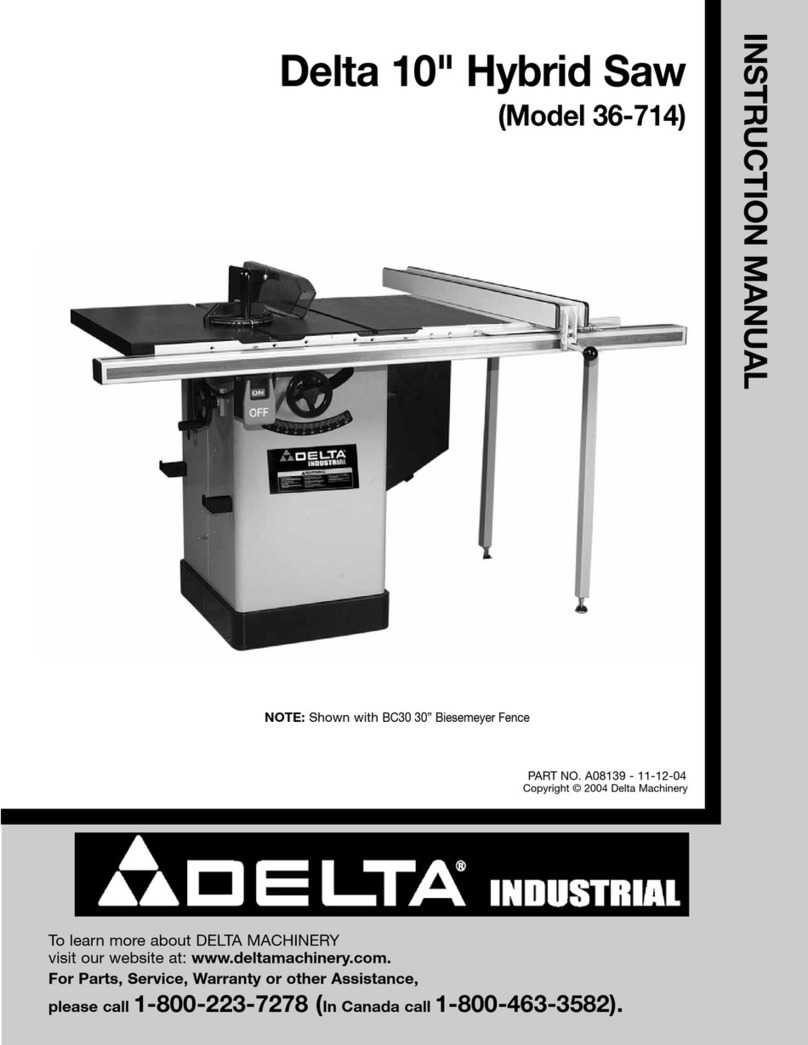
Delta
Delta 36-714 User manual
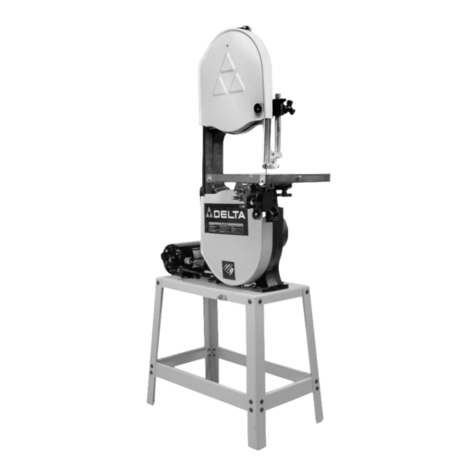
Delta
Delta 28-278 User manual
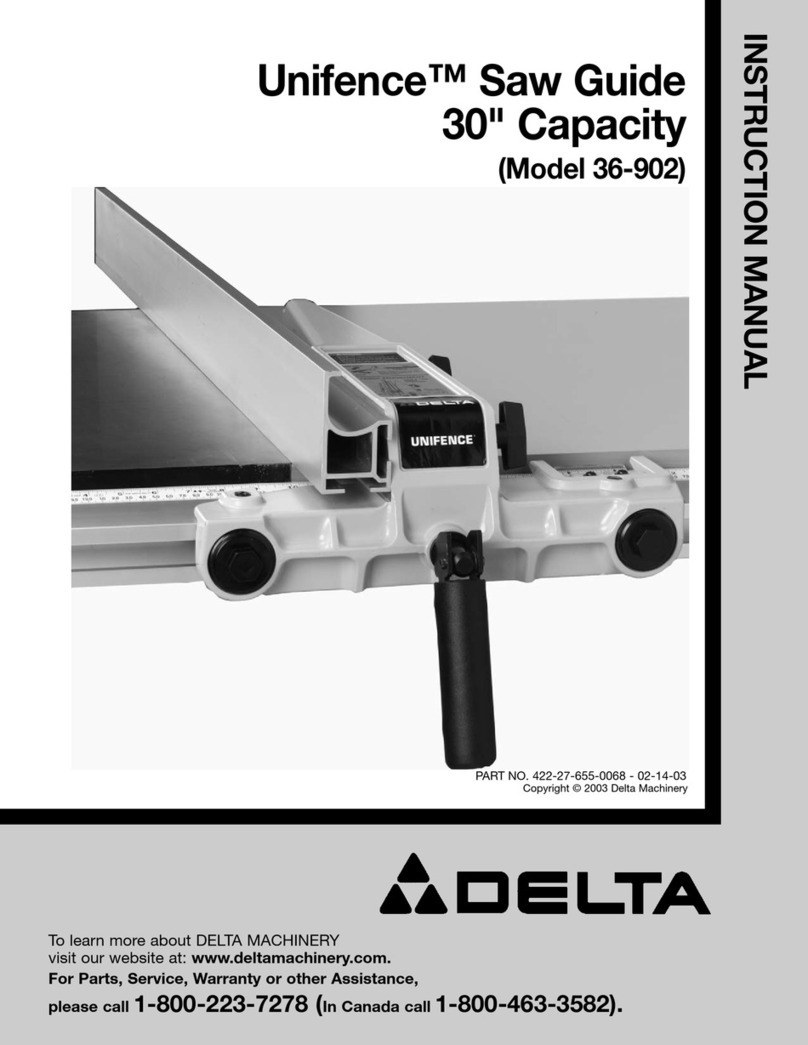
Delta
Delta Unifence 36-902 User manual

Delta
Delta SHOPMASTER 28-248 User manual
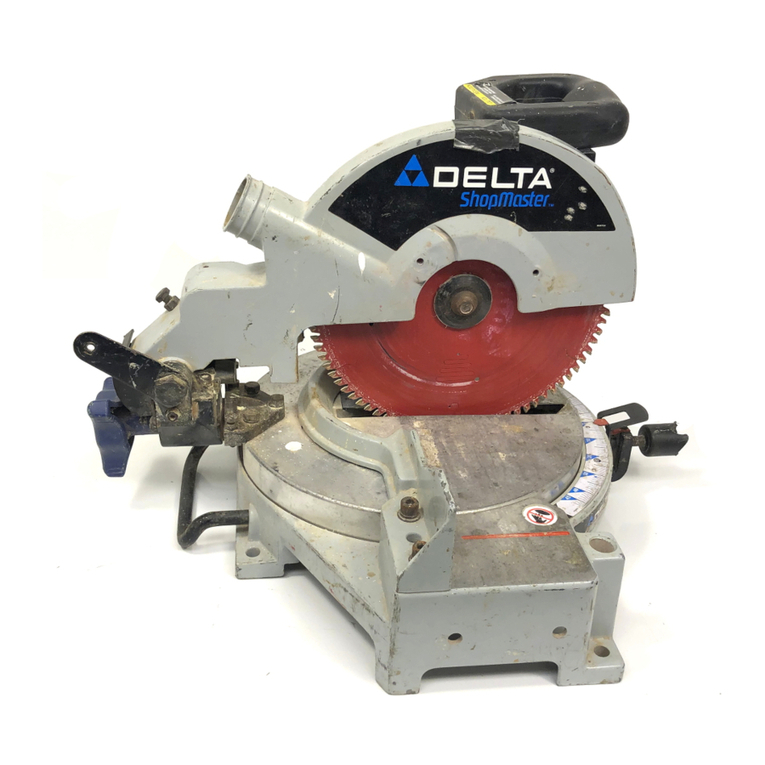
Delta
Delta ShopMaster MS250 User manual
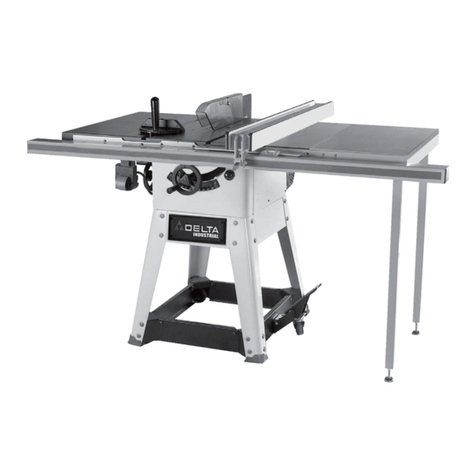
Delta
Delta 36-978 User manual
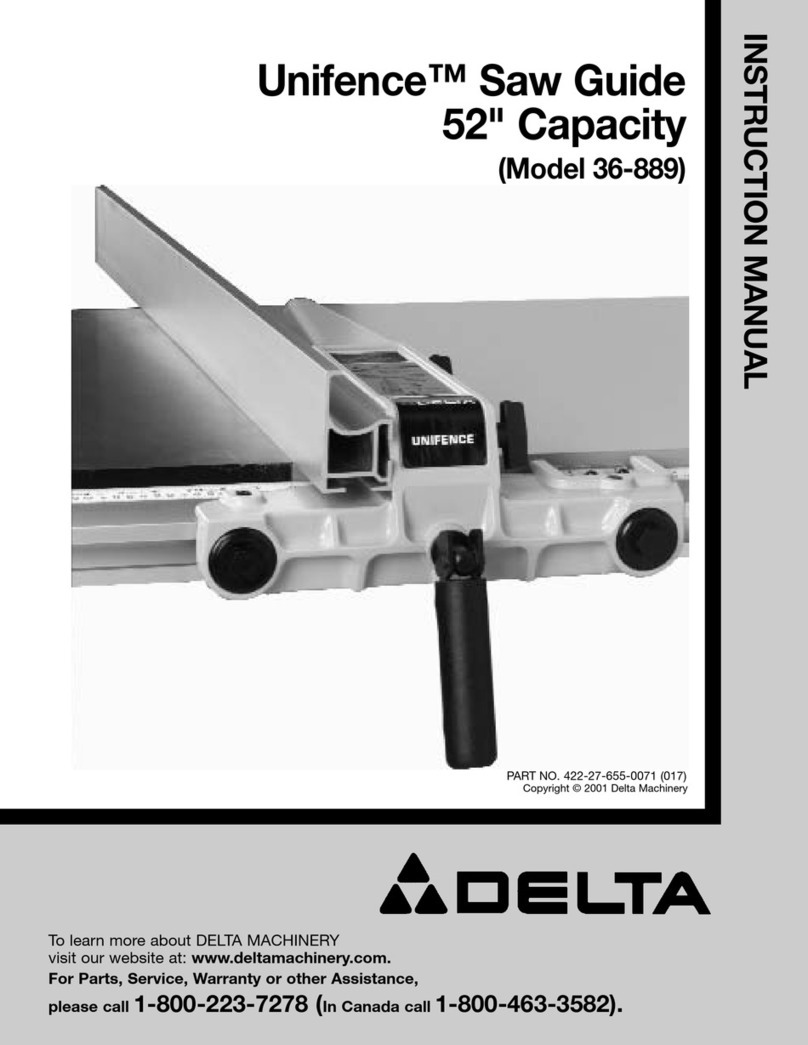
Delta
Delta 36-889 User manual
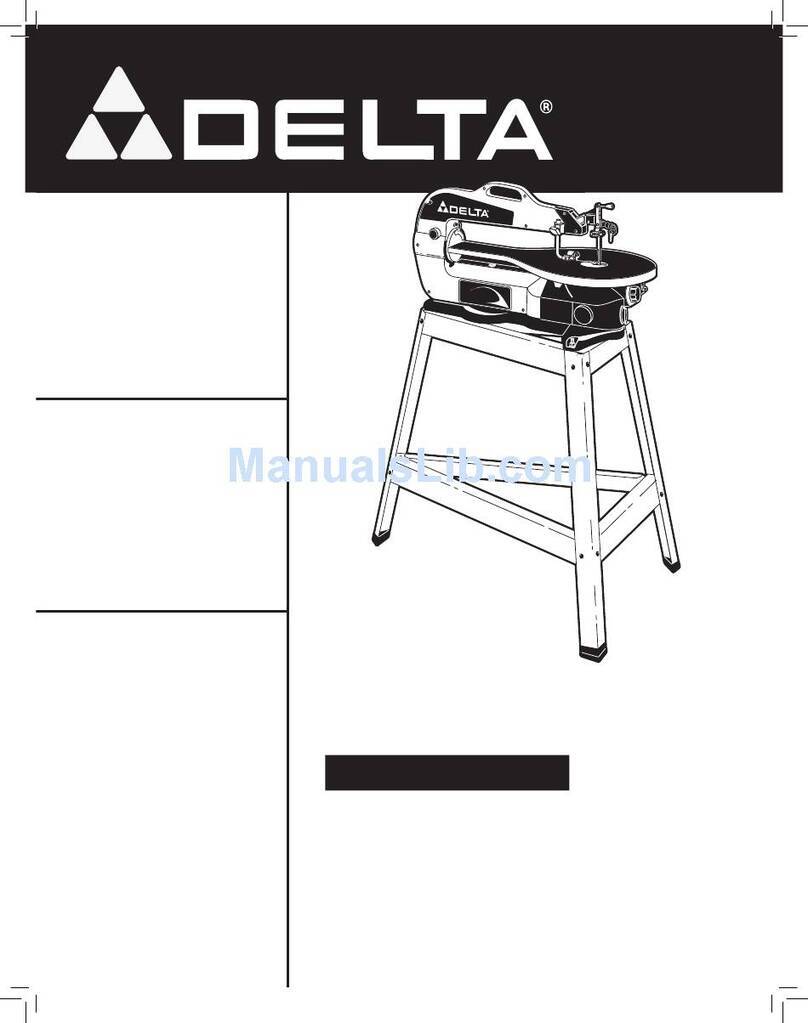
Delta
Delta SS350LS User manual
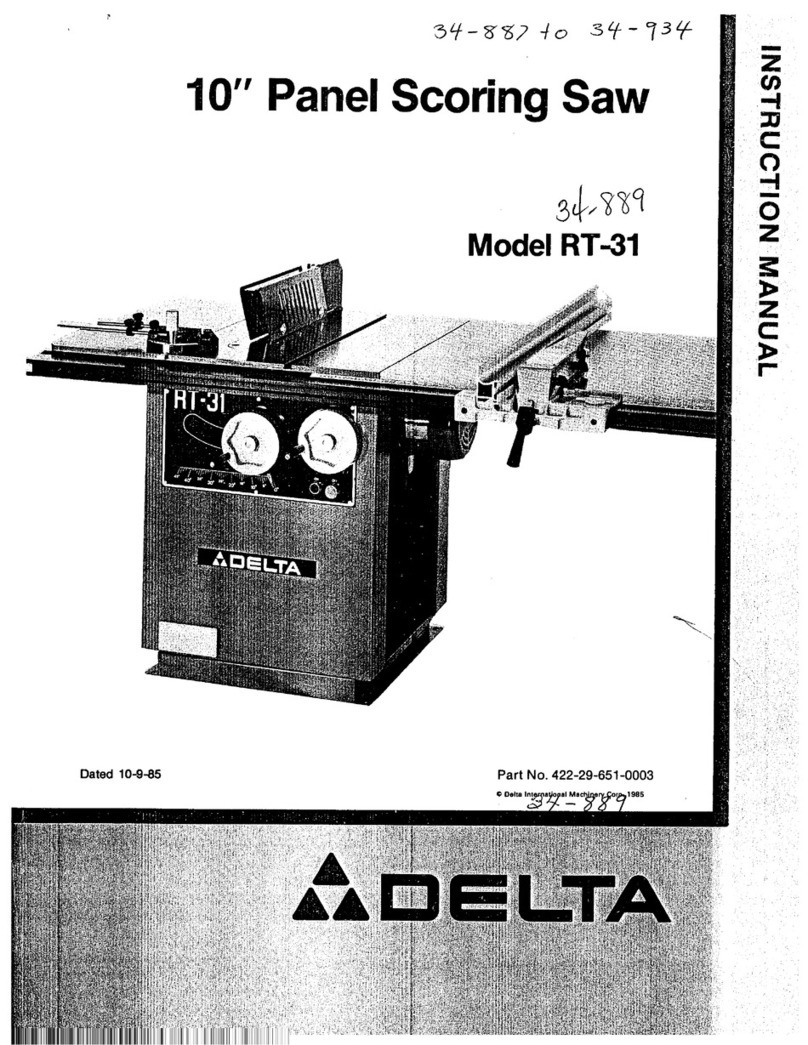
Delta
Delta RT-31 User manual
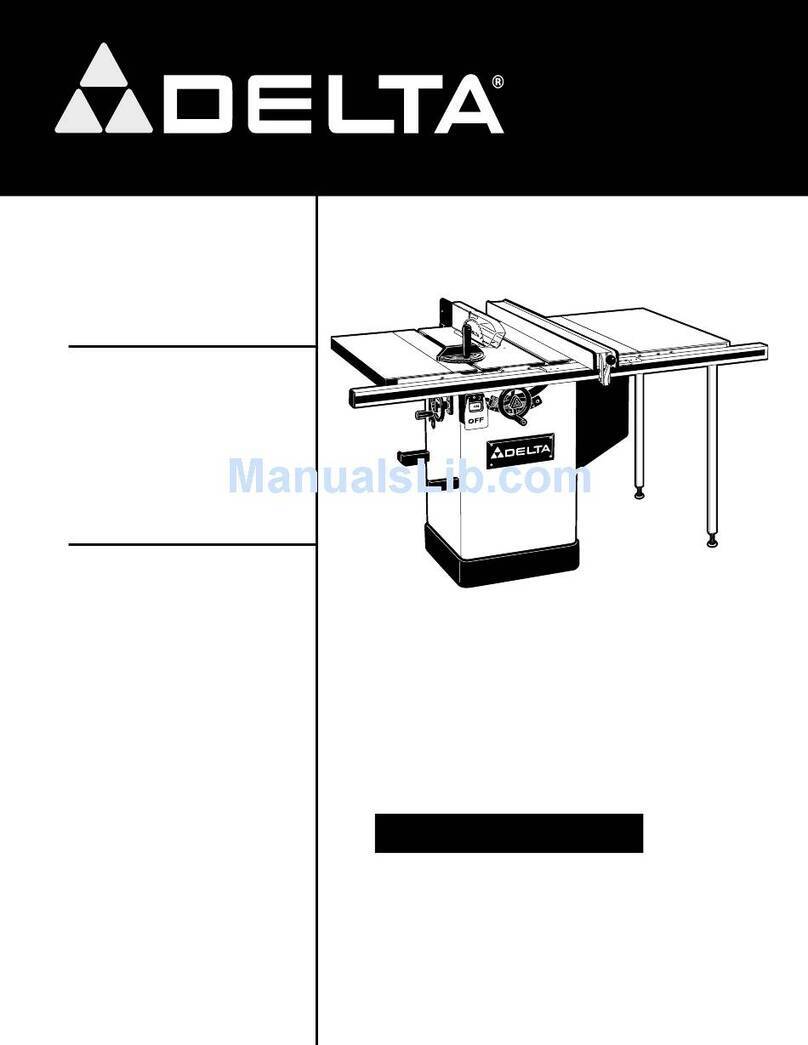
Delta
Delta 36-714 User manual
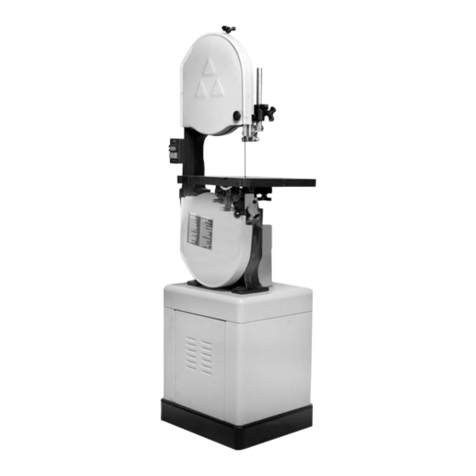
Delta
Delta 28-280 User manual

Delta
Delta 28-150 User manual
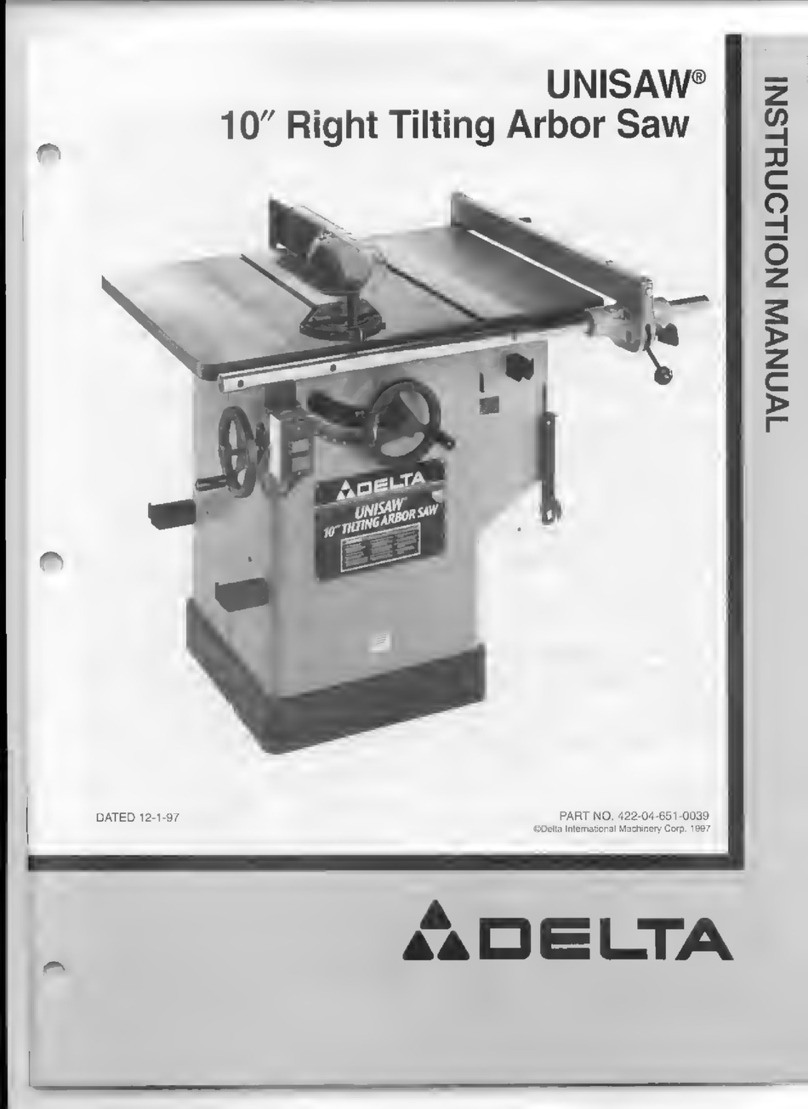
Delta
Delta UNISAW User manual
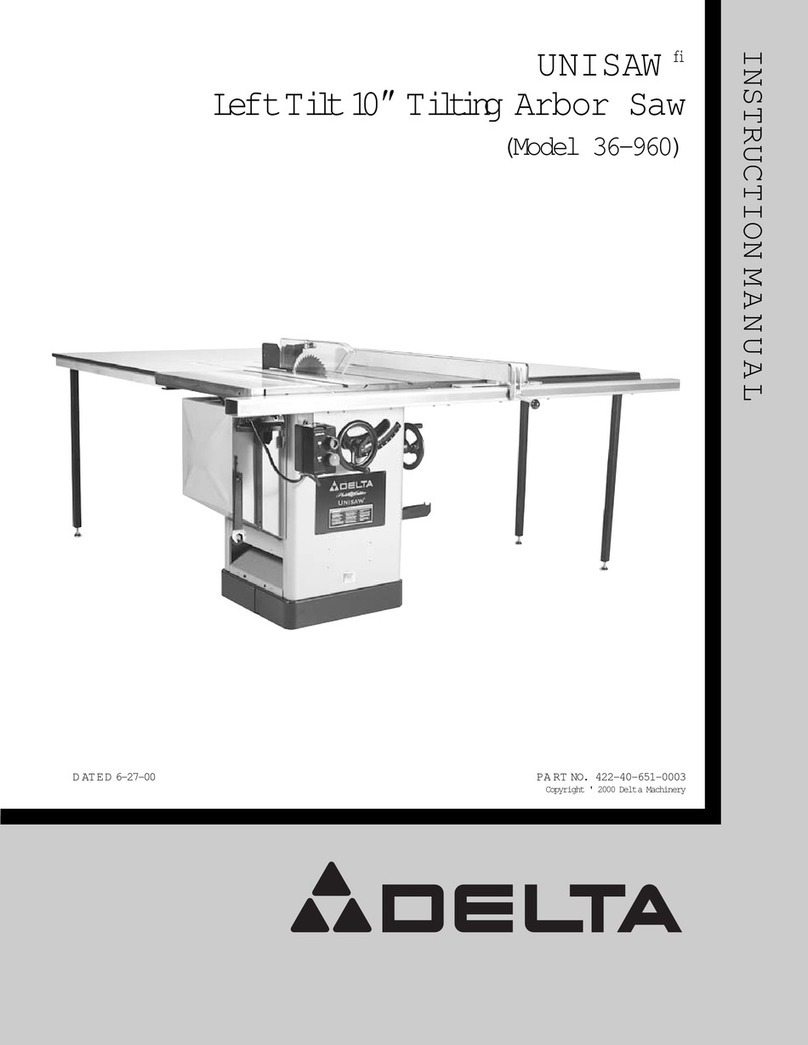
Delta
Delta 36-960 User manual
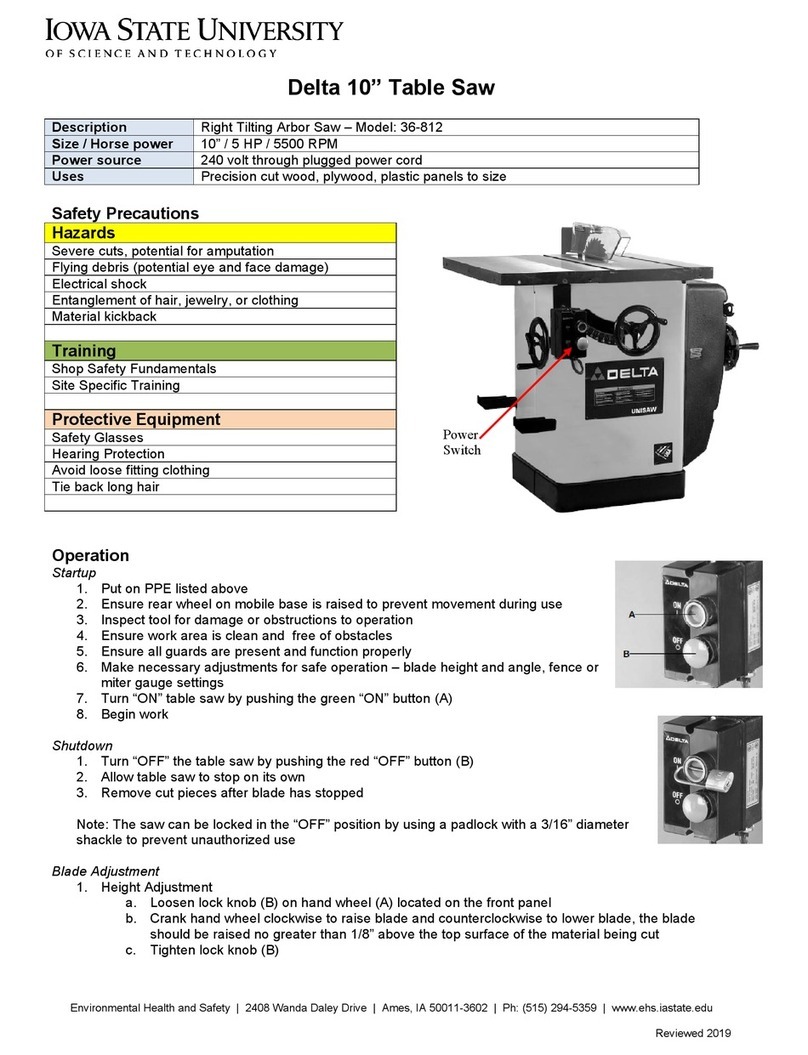
Delta
Delta UNISAW 36-812 User manual
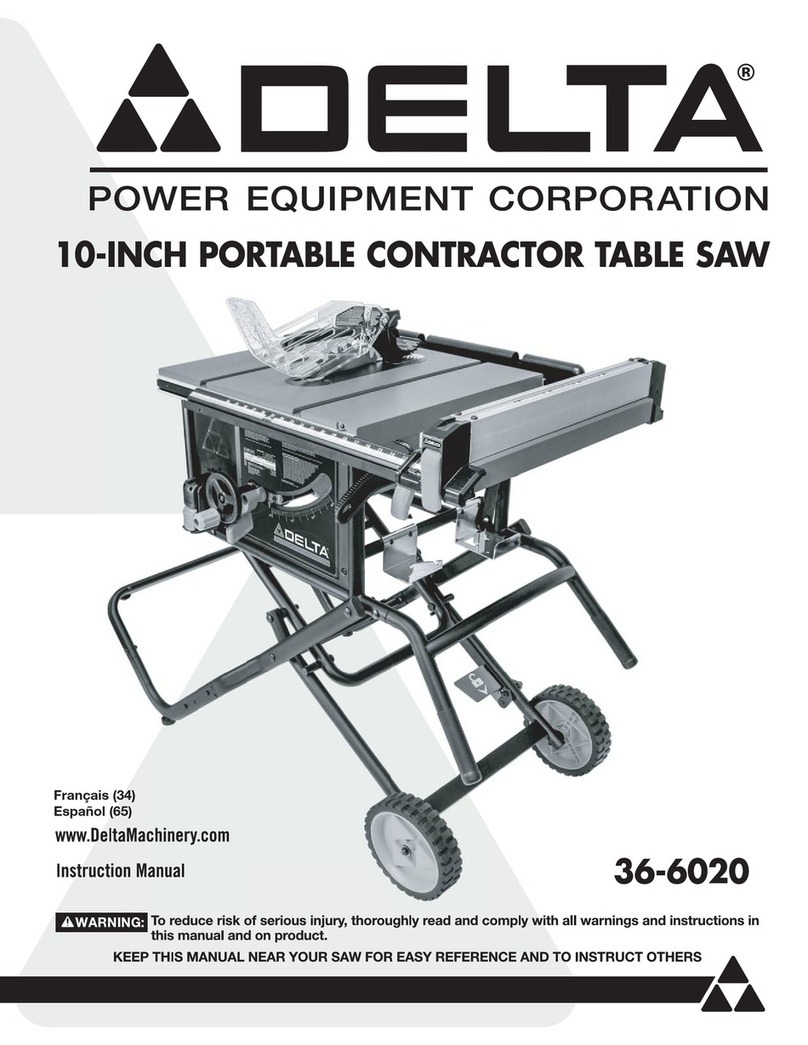
Delta
Delta 36-6020 User manual

Delta
Delta 36-475 User manual
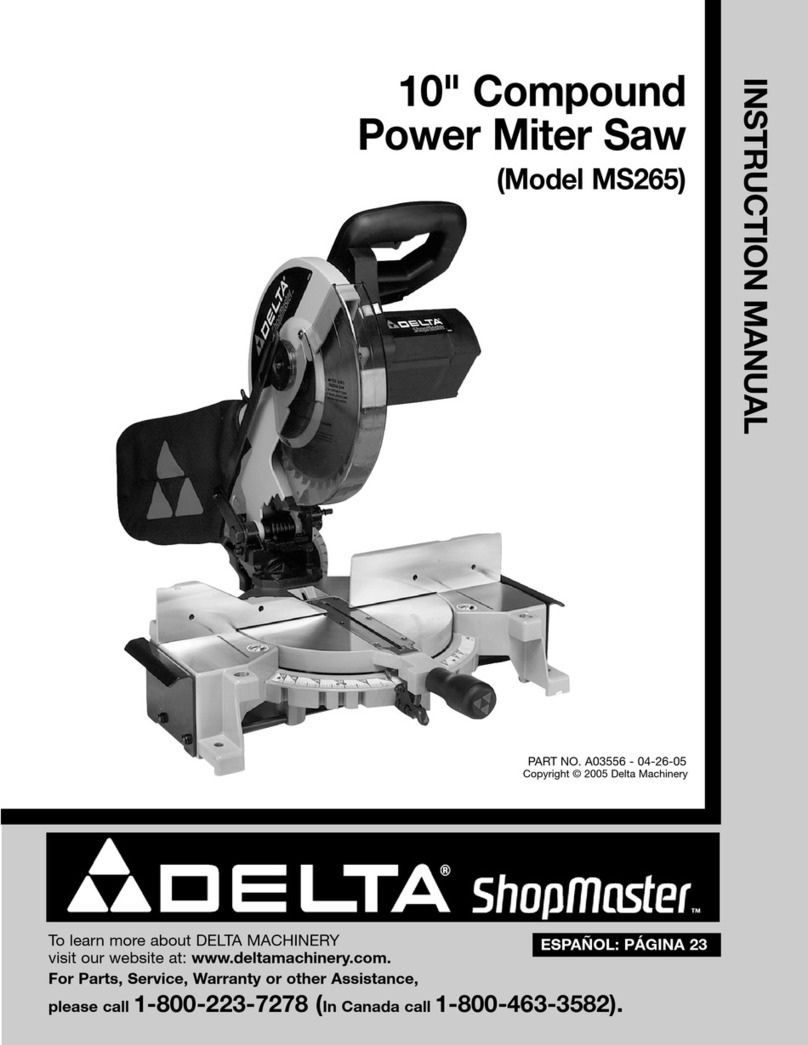
Delta
Delta ShopMaster MS265 User manual

Delta
Delta N028314 User manual


